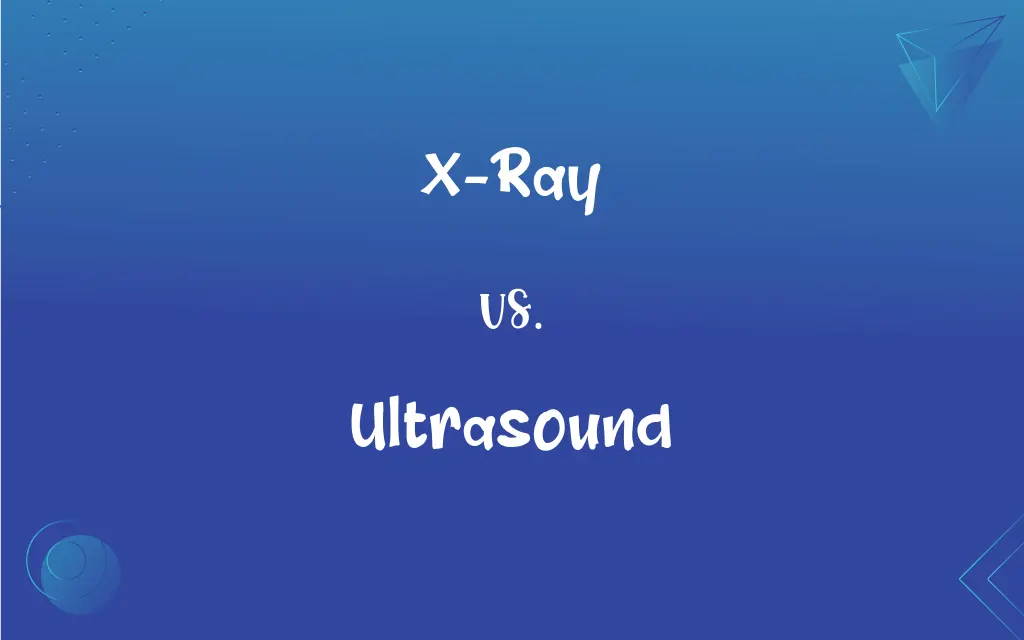X-Ray vs. Ultrasound: What's the Difference?
Edited by Aimie Carlson || By Janet White || Published on January 6, 2024
X-ray is a form of electromagnetic radiation used for imaging bones and internal structures. Ultrasound uses high-frequency sound waves to create images of internal body structures.

Key Differences
X-rays are a type of electromagnetic radiation used in medical imaging to view internal structures, particularly bones. Ultrasounds, on the other hand, employ high-frequency sound waves to produce images of soft tissues and organs.
X-ray imaging is highly effective for diagnosing fractures and observing skeletal anomalies. Ultrasound is preferred for examining soft tissues, like muscles, blood vessels, and organs, due to its safety and non-invasiveness.
X-rays can expose patients to low levels of radiation, ultrasounds are radiation-free and considered safer, especially for pregnant women. X-rays provide clear images of dense structures, whereas ultrasounds excel in visualizing fluid-filled structures.
X-rays are quick and efficient but cannot offer real-time imaging. Ultrasound provides real-time imaging, useful in guiding procedures like biopsies or monitoring fetal development during pregnancy.
X-rays are best for imaging bones and certain lung conditions, while ultrasounds are ideal for evaluating soft tissues, including the evaluation of fetal health in obstetrics.
ADVERTISEMENT
Comparison Chart
Type of Imaging
Electromagnetic radiation
High-frequency sound waves
Main Use
Bones, chest, and teeth
Soft tissues, blood flow, fetal imaging
Safety
Low-level radiation exposure
No radiation exposure
Imaging Capability
Static images
Real-time dynamic imaging
Diagnostic Strength
Effective for hard tissues
Effective for soft tissues and fluid detection
ADVERTISEMENT
X-Ray and Ultrasound Definitions
X-Ray
A diagnostic tool using electromagnetic radiation.
The doctor used an x-ray to confirm the bone fracture.
Ultrasound
A medical imaging technique using sound waves.
An ultrasound was performed to check the health of the fetus.
X-Ray
Can detect certain lung conditions.
A chest x-ray revealed signs of pneumonia.
Ultrasound
Safe for monitoring pregnancy.
Regular ultrasounds are important in prenatal care.
X-Ray
Commonly used in dental imaging.
Dental x-rays help in detecting cavities and tooth decay.
Ultrasound
Assists in guiding needle placement during biopsies.
The biopsy was performed using ultrasound guidance.
X-Ray
A photon of electromagnetic radiation of very short wavelength, ranging from about 10 down to 0.01 nanometers, and very high energy, ranging from about 100 up to 100,000 electron volts.
Ultrasound
Often used for abdominal organ imaging.
Liver conditions are commonly diagnosed with an ultrasound.
X-Ray
Often x-rays or X-rays A narrow beam of such photons. X-rays are used for their penetrating power in radiography, radiology, radiotherapy, and scientific research. Also called roentgen ray.
Ultrasound
Can visualize blood flow in vessels.
Ultrasound is used to detect blood clots and artery blockages.
X-Ray
A photograph taken with x-rays.
Ultrasound
Ultrasonic sound.
X-Ray
The act or process of taking such a photograph
Did the patient move during the x-ray?.
Ultrasound
The use of ultrasonic waves for diagnostic or therapeutic purposes, specifically to image an internal body structure, monitor a developing fetus, or generate localized deep heat to the tissues.
X-Ray
To irradiate with x-rays.
Ultrasound
An image produced by ultrasound.
X-Ray
To photograph with x-rays.
Ultrasound
(physics) Sound with a frequency greater than the upper limit of human hearing, which is approximately 20 kilohertz.
X-Ray
Examine by taking x-rays
Ultrasound
(medicine) The use of ultrasonic waves for diagnostic or therapeutic purposes.
X-Ray
Take an x-ray of something or somebody;
The doctor x-rayed my chest
Ultrasound
(ambitransitive) To treat with ultrasound.
X-Ray
Useful in identifying skeletal abnormalities.
X-rays can diagnose conditions like scoliosis.
Ultrasound
Very high frequency sound; used in ultrasonography
X-Ray
Sometimes used in mammography.
Mammograms, a type of x-ray, are crucial in breast cancer screening.
Ultrasound
Using the reflections of high-frequency sound waves to construct an image of a body organ (a sonogram); commonly used to observe fetal growth or study bodily organs
FAQs
Is x-ray imaging safe?
Yes, when used properly, though it involves low-level radiation exposure.
Can ultrasound be used during pregnancy?
Yes, it's safe and commonly used for monitoring fetal development.
How does ultrasound work?
It uses high-frequency sound waves to create images of internal body structures.
What is an x-ray?
A medical imaging technique using electromagnetic radiation.
How long does an x-ray procedure take?
Typically, it's a quick process, often completed in minutes.
Do x-rays show soft tissue?
X-rays are less effective for soft tissue compared to bones and dense structures.
What can x-rays diagnose?
X-rays are effective in diagnosing bone fractures, dental issues, and certain lung conditions.
Are ultrasounds effective for viewing bones?
No, ultrasounds are better suited for soft tissue imaging.
Can ultrasound detect cancer?
It can help in detecting and diagnosing certain types of cancer, especially when combined with other tests.
Is ultrasound imaging real-time?
Yes, it allows for real-time monitoring and imaging.
Can anyone have an x-ray?
Most people can, but it's avoided in pregnancy and reduced in children.
Can ultrasound guide surgical procedures?
Yes, it's often used to guide procedures like biopsies.
What makes x-rays different from CT scans?
CT scans provide more detailed, cross-sectional images compared to standard x-rays.
What are the limitations of ultrasound?
It has limitations in penetrating bone and imaging air-filled cavities.
How accurate is ultrasound in diagnosing conditions?
It's quite accurate, especially for soft tissue conditions.
How often can you safely have an x-ray?
There's no fixed limit, but unnecessary exposure should be avoided.
What preparation is needed for an ultrasound?
It varies; some require a full bladder or fasting.
Are there any side effects of x-rays?
Generally, no immediate side effects, but repeated exposure should be monitored.
Is special equipment needed for ultrasound?
Yes, an ultrasound machine and a transducer are used.
Can x-rays detect tumors?
X-rays can suggest the presence of tumors, but further imaging is often needed.
About Author
Written by
Janet WhiteJanet White has been an esteemed writer and blogger for Difference Wiki. Holding a Master's degree in Science and Medical Journalism from the prestigious Boston University, she has consistently demonstrated her expertise and passion for her field. When she's not immersed in her work, Janet relishes her time exercising, delving into a good book, and cherishing moments with friends and family.
Edited by
Aimie CarlsonAimie Carlson, holding a master's degree in English literature, is a fervent English language enthusiast. She lends her writing talents to Difference Wiki, a prominent website that specializes in comparisons, offering readers insightful analyses that both captivate and inform.
































































